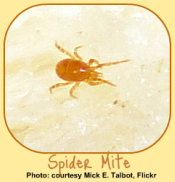- Home
CARE for your HOUSE PLANTSGROWING HOUSE PLANTSCHILDREN & PETS & PLANTSGIFTS for the INDOOR GARDENERSCIENCE of HOUSE PLANTSSITE LOGISTICS- Tell your story
|
Spider Mites
Info for the Indoor Gardener
Spider mites are among the most common garden pests to plague the Indoor Gardener. Here's how to find them and stop them in their tracks.
DESCRIPTION
- Spider mites look like little specks on small webs
- about 1/50th inch or less
- size of salt crystals
- no antennae
- whiplike mouths
- red, brown, yellow, green - color depends on species and time of year
- 8 legs
- 6 legs on young
- oval body
- two red spots near front on common houseplant species
- females have dark blotches on each side of body
- bristles on legs and body
- you'll see webbing on plant before you can detect the spider mites

LOCATION
- top of leaves
- bottom of leaves
- at joints of leaves and stems
- usually on lower parts of the plant
MULTIPLICATION
- these garden pests proliferate in dry air
- can crawl or be blown to nearby plants
- reproduce 1 to 2 times/week
- increase rapidly (see scientific life cycle info, below
DESTRUCTION
- the mites pierce holes in the leaves
- plant loses internal water from the holes as well as cell structure
- sucks out he contents of the plant's cells
- leaves turn yellow, then bronze, then fall off
DETECTION
- look for yellow stippling or specking on leaves
- use a magnifying glass (10x) every few weeks to check your plants
- leaf surface will show a white webbing
- shake leaf over white paper - if there, you'll see them running on the paper
SOLUTION
- isolate your houseplant quickly
- increase humidity around the plant
- prevention:
- frequently mist your plants
- showers in tub or sink every now and then
- keep plants dust free
- as soon as you notice the mites or the webbing, spray with 10% rubbing alcohol, dish or miticidal soap, and water 1x/week for at least 3 weeks
- use horticultural oils, such as Neem oils
- make sure your organic or chemical arsenal against these garden pests is specifically for these garden pests; they're not an insect and many insecticides don't work against them
- if plant is overrun, destroy it
- continue treatment to be sure they don't return (most treatment doesn't work against the eggs, so repeat regularly)
- keep in filtered sunlight while treating
- keep soil slightly moist while treating
- spray weekly with soap and water
- use foliar insecticides made for indoor plants every 7-10 days (per product instructions)
- chemicals: few insecticides work and few products work safely indoors: if you use a miticide (follow directions carefully) against them, treat every 10-14 days to kill off the next generation
- treat all plants that may have spider mites at one time
- treat outdoors if possible, especially if you have children and/or pets in the house
- In greenhouses, conservatory, or separate room use natural predators:
- predatory mites of the Phystoseiidae Family
- small ladybugs (especially Stethorus species
- pirate bugs
- predatory thrips
- lacewings
- syrphid flies
For Botanists, Scientists, Outdoor Gardeners, and School Reports
FAMILY: Tetranychidae
COMMON SPECIES: Tetranychus urticae, two-spotted spider mite
|
|
|
